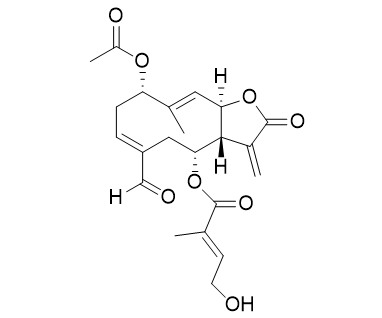Eupalinolide O
Eupalinolide O shows significant anticancer activity, it induces cell cycle arrest and apoptosis in human MDA-MB-468 breast cancer cells.
Inquire / Order:
manager@chemfaces.com
Technical Inquiries:
service@chemfaces.com
Tel:
+86-27-84237783
Fax:
+86-27-84254680
Address:
1 Building, No. 83, CheCheng Rd., Wuhan Economic and Technological Development Zone, Wuhan, Hubei 430056, PRC
Providing storage is as stated on the product vial and the vial is kept tightly sealed, the product can be stored for up to
24 months(2-8C).
Wherever possible, you should prepare and use solutions on the same day. However, if you need to make up stock solutions in advance, we recommend that you store the solution as aliquots in tightly sealed vials at -20C. Generally, these will be useable for up to two weeks. Before use, and prior to opening the vial we recommend that you allow your product to equilibrate to room temperature for at least 1 hour.
Need more advice on solubility, usage and handling? Please email to: service@chemfaces.com
The packaging of the product may have turned upside down during transportation, resulting in the natural compounds adhering to the neck or cap of the vial. take the vial out of its packaging and gently shake to let the compounds fall to the bottom of the vial. for liquid products, centrifuge at 200-500 RPM to gather the liquid at the bottom of the vial. try to avoid loss or contamination during handling.
Food and Chemical Toxicology2020, 111221
Integr Cancer Ther.2018, 17(3):832-843
Phytother Res.2019, 33(7):1784-1793
Antioxidants.2022, 11(3):491.
Environ Toxicol.2024, 39(4):2417-2428.
Int J Cosmet Sci.2023, 45(2):155-165.
Processes2022, 10(10), 2008.
Natural Product Communications2020, doi: 10.1177.
Microb Biotechnol.2021, 14(5):2009-2024.
LWT2020, 126:109313
Related and Featured Products
Nat Prod Res,2019 Feb;33(4):477-485.
Precise discovery of a STAT3 inhibitor from Eupatorium lindleyanum and evaluation of its activity of anti-triple-negative breast cancer.[Pubmed:
29086600]
Michael reaction acceptors (MRAs) are a class of active compounds. There is a great prospect to screen STAT3 inhibitors from Eupatorium lindleyanum, furthermore, to discover lead compounds for anti-triple-negative breast cancer (TNBC).
METHODS AND RESULTS:
In this study, glutathione (GSH) was employed, and a UPLC-MS screening method was developed to discover MRAs. We screened MRAs which can inhibit STAT3 using a STAT3-dependent reporter system. Six sesquiterpene lactones, including a new compound Eupalinolide O (1), together with five known compounds, Eupalinolide I (2), Eupalinolide K (3), Eupalinolide H (4), Eupalinolide J (5) and Eupalinolide G (6) were isolated. Eupalinolide J was identified as MRA that decreased luciferase activity of STAT3. Preliminary activity assessment showed that Eupalinolide J could inhibit the viability of TNBC cell lines.
CONCLUSIONS:
We demonstrated that Eupalinolide J, which is a natural typical MRA, has a notable inhibition of STAT3 activity and a potential cytotoxic activity against TNBC cell lines.
Bioorg. Med. Chem.,2011 Nov 1;19(21):6254-60.
Eupalinolide O, a novel sesquiterpene lactone from Eupatorium lindleyanum DC., induces cell cycle arrest and apoptosis in human MDA-MB-468 breast cancer cells.[Reference:
WebLink]
Sesquiterpene lactones have been confirmed to have potential antitumor activity.
METHODS AND RESULTS:
Here, we demonstrated that Eupalinolide O (EO), a novel sesquiterpene lactone isolated from Eupatorium lindleyanum DC., showed significant anticancer activity against human MDA-MB-468 breast cancer cells. The cytotoxicity induced by EO was mediated by induction of apoptosis. Flow cytometric analysis demonstrated that EO treatment resulted in loss of the mitochondrial membrane potential in cancer cells which is regarded as a hallmark of apoptosis. Further study demonstrated that EO induced apoptotic cell death in the MDA-MB-468 cells through the activation of caspases. The effect of EO on the induction of apoptosis was significantly prevented by the treatment of pan-caspase inhibitor Z-VAD-FMK. We also found that EO treatment resulted in cell cycle arrest in the G2/M phase. The expression of cell cycle-related proteins (cyclin B1 and cdc2) was significantly decreased. Furthermore, the suppression of the Akt pathway in the MDA-MB-468 cells was observed.
CONCLUSIONS:
Collectively, EO suppressed the growth of the MDA-MB‑468 cells possibly by cell cycle arrest in the G2/M phase and the induction of caspase-dependent apoptosis.
These results suggest that EO is a promising natural compound for breast cancer therapy.



